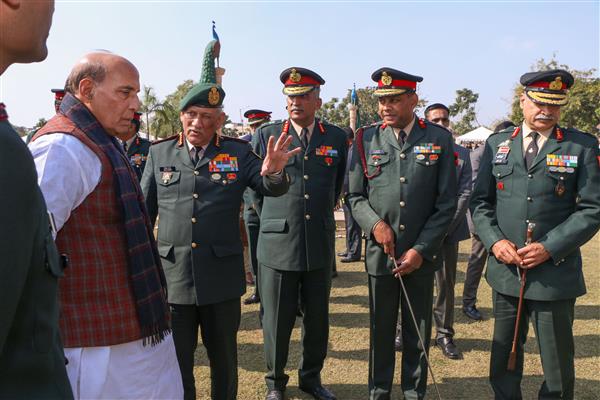National
What recovery of Austrian assault rifle from J&K terrorists means
Srinagar, July 20 (IANS) The recovery of an Austrian assault rifle from two slain foreign terrorists in Jammu & Kashmir’s Keran sector on July 18 has added another complex dimension to the ongoing terrorism in J&K.
The first weapon to be recovered from the militants in J&K was on September 12, 1988. Militants had attacked the residence of the then Deputy Inspector General of Police (DIG) Ali Mohammad Watali, in Raj Bagh residential area of Srinagar city.
One militant identified as Aijaz Dar, who lived in the nearby Jawahar Nagar area was killed in retaliatory firing by the guards at the DIG’s residence and one assault rifle was recovered from his possession.
Another senior police officer, Shaikh Owais was the Superintendent of Police (SP), Srinagar at that time. Owais was among the first senior officers to reach the DIG’s residence since he also lived in the same area.
This was a weapon not in use in the police force, nor was it the standard weapon issued to the army back then. At a meeting of the experts called in from the army, the weapon was identified as Kalashnikov.
It belonged to a family of assault rifles also known as AK platform, AK rifle or simply AK based on the original design of Mikhail Kalashnikov. Experts identified the rifle as AK-47, officially known as the Avtomat Kalashnikova which is the originating firearm of the Kalashnikov family of rifles.
It was developed in the Soviet Union by Russian small-arms designer Mikhail Kalashnikov in the middle of the 20th century.
“AK-47’s name stands for Automat Kalashnikova 1947, the year it was first produced. In 1949, the AK-47 became the assault rifle of the Soviet Army,” an officer said.
Over the years, since 1988, the militants started using long-range sniper rifles and also the subsequent versions of the AK rifle series like AK-54 and AK-74 denoting the year of manufacture of the rifle with improvements over the original AK-47 version.
J&K police force was not issued any assault rifle of the AK series till then, and to combat the firepower of the adversary, police, paramilitary and the army were subsequently issued assault rifles of the AK series as well in addition to Indian-made INSAS rifles.
“The possession of AK assault rifles by the militants unequivocally established that they had been trained and issued weapons by trainers of the Pakistan army. Due to the presence of the Russians in Afghanistan and Pakistan’s support to the Afghan militias, AK rifles were aplenty in Pakistan since practically no border existed between the two countries at that time,” said a senior intelligence officer.
As militancy sprouted into outright terrorism by the entry of the foreign mercenaries into J&K by the middle of 1990s, more weapons in their improvised versions like AK-54, AK-74 and under-barrel grenade launchers (UBGLs) came to be used by the terrorists.
Since the foreign mercenaries were battle-hardened, the security forces had to live up to the growing challenge by introducing Para commandos and those trained in mountain warfare into its anti-terrorism operations in J&K.
“J&K police also underwent a sweeping change in its training of commandos, use and expertise of modern assault rifles and strenuous training in developing stamina and focus. Commitment to eradicate terrorism and usher in peace was the preamble of such training,” said a senior police officer supervising physical and weapon handling training of the local police force.
Paramilitary forces like BSF and CRPF were not behind in bringing their troops up to the maximum level of efficiency to deal with terrorism in different parts of the country.
As terrorism started getting more hands by way of foreign mercenaries who were pushed into J&K from across the border, motivated and indoctrinated by both religious fanaticism and the lure of money, the handlers and their masters in the Pakistan army started encouraging them with better weapons.
On July 11, 2022, one M4 carbine rifle was recovered from an encounter site in the Awantipora area of Jammu and Kashmir’s Pulwama district where Jaish-e-Muhammad commander, Kaiser Koka and one another terrorist were killed.
This was a new challenge for the security forces. The M4 carbine also replaced most submachine guns and selected handguns in US military service, as it fired more effective rifle ammunition that offered superior stopping power and was better able to penetrate modern body armour.
“A review had become necessary of the bulletproof vests issued to the security forces. The older version of the BP jacket wouldn’t suffice to meet the new challenge.
“Better and lighter BP jackets have been issued to security forces fighting terrorism and these are designed to stop the armour-piercing bullets,” said another senior police officer deployed on anti-terrorism operations.
While M4 assault rifle is US-made and it is issued to the American army, it is obvious that while leaving Afghanistan, the US forces left behind some of their sophisticated weaponry which came into the hands of the Afghan fighters. This assault rifle found its way into J&K through Pakistan.
On July 17, 2024, two foreign terrorists were killed by the army while foiling an infiltration bid on the LoC in the Keran sector.
A Steyr AUG assault rifle was recovered from the slain terrorists.
“The StG 77 (Sturmgewehr 77) is the designation given by the Austrian Armed Forces when they adopted the Steyr AUG in 1977. This is the standard assault rifle issued to the Austrian army.
“The Steyr bullpup assault rifle is only matched by the Israeli-made Tavor assault rifle.
“Tavor is a gas-operated, selective-fire bullpup assault rifle built around a long-stroke piston system. The main objective behind the development of Tavor is to maximise reliability, durability, simplicity of design, and maintenance-free, particularly under unfavourable or battlefield conditions.
“Tavor has a semi-automatic mode, burst mode and full-auto mode chambered in standard 5.56×45 mm ammunition. It is considered to be more reliable and accurate than M4 carbine of the US and Steyr of Austria. The Tavor TAR-21 holds magazines of 30 rounds,” said an arms expert.
“As challenges are in plenty for the security forces fighting terrorism in J&K, weapons systems, armour-resistant apparel and other equipment used by our security forces are regularly and constantly reviewed.
“A couple of M4 carbine rifles or Austrian bullpup assault rifles cannot save the terrorist from a professionally trained and highly modernised army of India,” said the senior intelligence officer.
For obvious reasons, no serving intelligence, security forces and army expert speaking to IANS agreed to be quoted by name.
–IANS
sq/kvd
National
Defence Ministry: Year 2025 will be year of reforms

On Wednesday, the Defence Ministry announced that 2025 will be designated as the “Year of Reforms,” with a primary focus on establishing integrated theatre commands to enhance collaboration among the three branches of the military.
These reforms are aimed at transforming the armed forces into a technologically advanced, combat-ready force capable of executing multi-domain integrated operations, the ministry stated.
The initiative will emphasize emerging domains such as cyber and space, alongside cutting-edge technologies like artificial intelligence, machine learning, hypersonics, and robotics.
Defence Minister Rajnath Singh described the “Year of Reforms” as a pivotal milestone in the modernization of the armed forces.
“It will set the stage for significant advancements in the nation’s defense capabilities, ensuring the security and sovereignty of India in the face of 21st-century challenges,” he said.
National
A 3.2 magnitude tremor struck Gujarat’s Kutch district on Wednesday morning

A 3.2 magnitude tremor struck Gujarat’s Kutch district on Wednesday morning, according to the Institute of Seismological Research (ISR).
The district administration reported no casualties or property damage following the quake.
The tremor occurred at 10:24 am, with its epicenter located 23 kilometers north-northeast (NNE) of Bhachau, as per the Gandhinagar-based ISR.
Last month, the region experienced four seismic events exceeding a magnitude of 3, including a 3.2 magnitude tremor just three days ago, with its epicenter also near Bhachau.
Earlier tremors in the area included a 3.7 magnitude earthquake on December 23 and a 3.2 magnitude event on December 7, according to ISR reports.
Kutch was also jolted by a 4.0 magnitude earthquake on November 18, 2024. On November 15, a 4.2 magnitude quake hit Patan in north Gujarat, based on ISR data.
Gujarat is considered a high-risk earthquake zone, having experienced nine major earthquakes over the past 200 years, according to the Gujarat State Disaster Management Authority (GSDMA). The 2001 earthquake in Kutch, which occurred on January 26, was the third-largest and second-most destructive in India in the last two centuries, according to the GSDMA.
National
Diljit Dosanjh faces legal action over concert songs

Singer and actor Diljit Dosanjh’s much-anticipated New Year’s Eve concert in Ludhiana faced legal hurdles after a complaint was filed by Punditrao Dharenavar, an assistant professor from Chandigarh.
Following the complaint, the Deputy Director of the Women and Child Department, Government of Punjab, issued a formal notice to Ludhiana’s District Commissioner, urging them to prohibit Dosanjh from performing specific songs during his live show on December 31, 2024.
The notice specifically targets songs accused of promoting alcohol, including Patiala Peg, 5 Tara Theke, and Case (Jeeb Vicho Feem Labbiya), even if the lyrics are slightly modified. The complaint points to previous warnings issued to Dosanjh by various commissions advising against performing these controversial tracks.
Despite these warnings, the singer allegedly continues to perform the songs with minor alterations. Dharenavar raised serious concerns about the influence of such music on young audiences, especially when minors are present at live events.
Adding to the controversy, Dharenavar referenced a 2019 Punjab and Haryana High Court ruling, which directed law enforcement to ensure that songs promoting alcohol, drugs, or violence are not played at public events, including concerts. This ruling underscores the legal basis for the complaint and has further intensified the scrutiny surrounding the event.
National
UP Minister’s convoy overturns, 5 person injured

Five people sustained injuries when a vehicle in the convoy of Uttar Pradesh Minister and Nishad Party chief Sanjay Nishad overturned into a ditch near Januan village in the Khejuri Police Station area of Ballia district late last night.
Sanjay Nishad shared details of the incident, stating that the accident injured five party workers, including four women.
“I was traveling with the convoy to participate in the Constitutional Rights Yatra organized by the party on Tuesday night. Near Januan village in the Khejuri area, one of the vehicles following the convoy lost control while trying to avoid an animal and overturned into a ditch,” Nishad explained.
The injured individuals have been identified as Rakesh Nishad, Ramrati, Usha, Geeta, and Iravati Nishad.
Senior police and administrative officials quickly arrived at the scene following the incident to oversee the situation.
National
Suchir Balaji’s mother alleges Murder


The mother of Suchir Balaji, a 26-year-old former OpenAI researcher found dead after accusing the company of copyright violations, has alleged that her son was “murdered” and called for a Federal Bureau of Investigation (FBI) probe.
Poornima Rao, Suchir’s mother, claimed her son’s death was a “cold-blooded murder” that authorities wrongly ruled as suicide. She further disclosed that a private autopsy report conflicted with the findings of the initial police investigation.
Rao alleged that her son’s apartment had been “ransacked” and cited evidence of a struggle in the bathroom, including bloodstains that suggested he had been assaulted.
“We hired a private investigator and conducted a second autopsy to uncover the truth. The private autopsy does not confirm the cause of death stated by the police. Suchir’s apartment was ransacked, there were signs of a struggle in the bathroom, and it appears he was hit based on blood spots. This is a cold-blooded murder being misclassified as a suicide. Lobbying in San Francisco won’t deter us from seeking justice. We demand an FBI investigation,” Rao wrote on X.
Elon Musk reacted to Rao’s post, commenting, “This doesn’t seem like a suicide.”
Balaji was discovered dead in his San Francisco apartment months after accusing OpenAI of violating copyright laws during the development of ChatGPT, as reported by Fox News. Despite these claims, the San Francisco Police Department found no evidence of foul play and ruled the death a suicide.
On October 24, shortly before his death, Balaji voiced doubts about the “fair use” defense in generative artificial intelligence. “I recently participated in a NYT story about fair use and generative AI, and why I’m skeptical ‘fair use’ would be a plausible defense for a lot of generative AI products,” he wrote on X.
-
Video2 years ago
PM Modi Attacks Congress in Karnataka with “Kerala Story”
-
Politics2 years ago
Siddaramaiah & DK Shivakumar sworn in as Chief Minister & Deputy CM respectively
-
Cricket2 years ago
CSK players rejoice 5th IPL title with their families (Pics)
-
Entertainment2 years ago
Karan Deol weds his longtime Girlfriend Drisha Acharya (Pics)
-
Sports7 years ago
History Of Official FIFA WORLD CUP Match balls
-
India2 years ago
Ashwini Vaishnaw: Railway Board recommends CBI probe in the Odisha railway disaster
-
Entertainment2 years ago
Urvashi Rautela dazzles on Cannes 2023 red carpet (Pics)
-
Entertainment2 years ago
Sunny Leone gets ready for Kennedy premiere in Cannes (Pics)



























